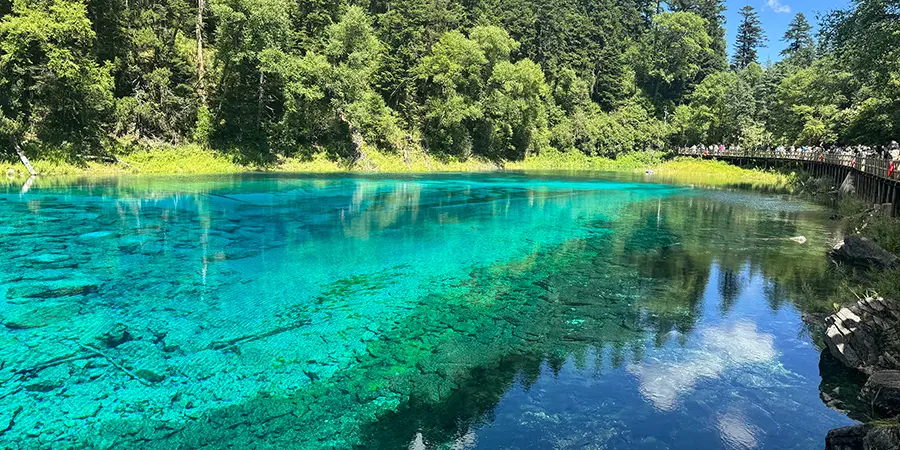Jiuzhai Valley National Park is located in Nanping County, 450 kilometers (about 280 miles) to the north of Chengdu City. Its name is due to the existence of nine stockaded villages of Tibetan origin, and it is always regarded as a holy mountain and watercourse by the Tibetan people.
It is a great masterpiece of nature having dreamlike scenery, which combines blue lakes, waterfalls, verdant forests, snow-covered mountains, and the folk customs of the Tibetan and Qiang peoples. Legend has it that long long ago the deity of mountain named Dago had a crush on the goddess Semo, and he gave a mirror that was made from wind and cloud to the goddess. However, the devil appeared and made trouble to Semo. Inadvertently, Semo broke the mirror into 108 pieces, which fell down to the earth and then turned to 108 colorful lakes. The lake is also called Haizi by local people.

(Click to enlarge)In addition to the dreamlike sceneries, there are numerous flora and fauna in the scenic area. The natural forest covers an area of nearly 30,000 hectares (about 74,132 acres), including 2,576 higher plant species (24 species of national protected plants) and over 400 lower plant species (212 species of algae). The diversity of flora has provided a good environment for wild animals. There are 170 species of vertebrates, 141 species of birds and 17 species of rare animals. Among them the first rank has giant pandas, takins and golden monkeys and the second rank has lesser pandas, marmots, and blue sheep.
Jiuzhaigou Valley Scenic and Historic Interest Area covers more than 600 square kilometers (about 230 square miles). Shuzheng Valley, Rize Valley and Zechawa Valley are the three main valleys, but the sceneries are far more than you expect. There are Panda Lake Waterfall which has the longest drop in Jiuzhai Valley and freezes to a crystal world in winter, the giant calc-sinter beach Pearl Beach, the Arrow Bamboo Lake that has a large area of bamboo, the favorite food of pandas, and Swan Lake where swans inhabit ...
Transportation:
Pearl Shoal Waterfall
By Air:
Jiuhuang Airport is about 88 kilometers from the mouth of the valley and about 52 kilometers from Huanglong. It takes 40 minutes to fly from Chengdu to the airport and a half hours' ride from the airport to the scenic area. There are direct and connecting flights here from Beijing, Shanghai, Guangzhou, Xi'an, Kunming, Chongqing and Xiamen. Please use China Flight to search for the latest schedule and price.
By Bus:
Regular buses from Chengdu Chadianzi Bus Station and Xinnanmen Bus Station depart around 7:00, 8:00 in the morning. It is suggested to buy the bus ticket in advance. It takes about 10-11 hours from Chengdu to Jiuzhaigou.
There are approximately two buses every day between Jiuzhaigou and Songpan, 7:00, 13:00 from Songpan and 7:30, 12:50 vice versa. In addition, there are regular buses from Guangyuan, Jiangyou and Mianyang to Jiuzhaigou. The bus schedule is adjusted to changes. Here is the travel time information by bus from some surrounding places to the scenic area:
from Jiangyou: 7 hours;
from Songpan: 2 hours;
from Huanglong: 3 hours;
from Mianyang: 8 hours
By train:
Chengdu - Jiuzhaigou Train will be operated between the two places by the end of 2019. By then, one can make a quick rail travel within 2 hours between Jiuzhai Valley and Chengdu.
Map of Jiuzhaigou Ring Way
(Click to enlarge)
Some self-driving routes are also suggested here:
From Chengdu
1. West Line: Chengdu – Dujiangyan – Wenchuan – Maoxian – Songpan – Jiuzhai Valley (total 440 km)
2. East Line: Chengdu – Mianyang – Jiangyou – Pingwu – Nanping – Jiuzhai Valley (total 475 km)
From Xi'an
Xian – Guangyuan – Zhaohua – Wenxian (Gansu Province) – Jiuzhai Valley (about 720 km)
From Lanzhou
1. Lanzhou – Linxia - Ruoergai Grassland – Chuanzhusi – Jiuzhai Valley (total 804 km)
2. Lanzhou – Lueyang – Chengxian – Wudu – Wenxian – Jiuzhai Valley (total 700 km)
From Dari (in southern Qinghai, adjacent to Sichuan Province)
Dari County – Aba County – Hongyuan Grassland – Mai Wa – Chuanzhusi - Jiuzhai Valley (total 768 km)